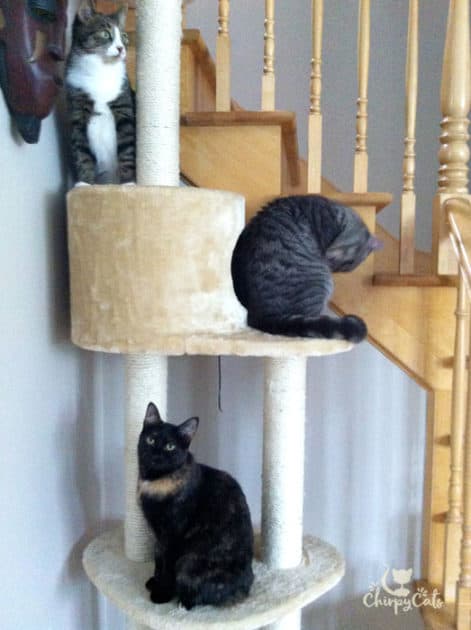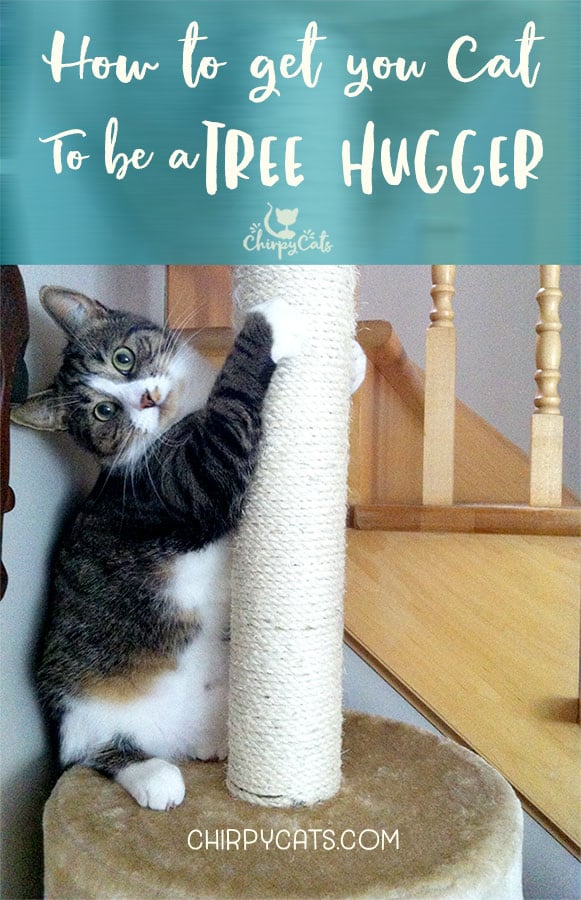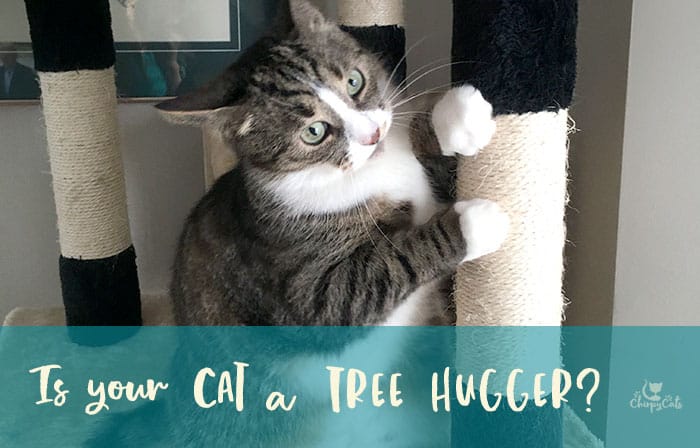Last updated August 11th, 2020
When your cat won’t use his scratching post or cat tree you may feel at your wit’s end. But perk up, because cats love learning, especially when the learning involves something that they were born to do. There are ways to turn your indifferent cat into a tree hugger.
I am a bit of a tree hugger. I cannot see a world without trees. I have pleasant memories of my childhood climbing our mango and avocado trees with my gangly long limbs trying to maneuver as high as I could. I felt happy and free like I could do anything, perched like a happy cat in a tree.
I admired my cat’s physiology that endowed him with beautifully curved wolverine claws and excellent tree-climbing prowess. I wanted to be like that cat. Except of course, when he got stuck up trees.
Fortunately for our indoor cats, they can scratch (pun intended) that activity off their daily diary:
Today I shall climb to the top of the cat tree and get stuck. Me, never!
Mr. Jack’s diary
Cats are natural tree huggers. Scratching is a ‘cativity’ that is essentially written in a cat’s DNA. It makes them feel confident, happy and is beneficial to a cat’s overall wellbeing. With so many cat trees available for indoor cats there is something to suit every furry tree hugger’s taste as well as every indoor space. But there are some cats that didn’t quite get the memo, and totally ignore their cat tree, preferring the couch instead.

Learning to scratch the tree is fun!
Six years ago Kevin decided to adopt three younger cats. My two older cats were well trained and I was not used to having a bunch of delinquents determined to scratch up our house. So action was needed and I decided to clicker train these juveniles to use their cat tree.

Armarkat Premium Cat Tree X6606
The Armarkat product line is both pet-centric and pet-friendly. Cat trees and steps com… [More]
Price: $165.00
George the Tree Hugger
When I started the training George was rather indifferent and sat on the far side of the living room, just quietly observing. He watched every move as I rewarded his friends Scout and Mr. Jack with a click and treat as they would do a half-arsed scratch on the tree. After about three minutes of observing the failings and ineptitude of his housemates, he scampered over excitedly and proceeded to hug the tree, looking up at me as if to say:
“I’m surrounded by amateurs! Guys, this is how it’s done!
George the Tree Hugger
I apologize for these somewhat grainy photos taken with an old iPhone and they were captured on that first day I started the training. But it captures the level of interest and expression on George’s face as he took over the clicker training session and owned it. It didn’t even matter that he was hugging rather than scratching. It was just precious to see how engaged George was after figuring it all out. It was amazing to watch how a simple food motivation exercise such as clicker training provided a positive form of confidence-building in a normally shy wallflower cat.



Mr. Jack the Ground Scratcher
In contrast, Mr. Jack’s life goals were less lofty and more grounded. His bad habit was scratching on any horizontal surface such as the area rug or the kitchen seats. He, unlike George, excelled at scratching various kinds of horizontal cardboard scratchers or those covered in carpet. Not that he doesn’t like the cat tree. In fact, after supper, he perches on the very top of the cat tree but prefers to do his main scratching workout on the horizontal scratchers.
In the 2013 video below, skip forward to 1:16 to see George owning his tree and hugging it! This still makes me laugh because he still does it today.
Why is my cat not using his scratching post?
This is one of the most commonly asked questions by new cat owners. They’ve bought a cat tree and the cats are not using it, preferring the furniture instead. Sometimes a slight adjustment in the way the cat tree has been set up is all that is needed. Perhaps you’ve positioned the cat tree in a space that is more appropriate for the humans and not the cats. For instance, you might have placed it at the back of or the periphery of a room, away from a window. Observe your cat’s rituals for clues on how to merge the positioning of the cat tree in line with how your cat or cats are communicating and connecting with their environment. There are many factors that might make the newly bought cat tree unattractive or even unpleasant to the cat.
Rental, rental, rental!
A good idea is to make the cat tree the center of the cats’ living space ie the cat’s ‘home base.’ This is a cat’s central territory where they eat, sleep and interact with their fellow cat clan, which includes the humans too! This is a cat’s core ecosystem where they leave little invisible post-it sticky scent notes for each other, through scratching and rubbing on certain household objects. This action is very comforting and reassuring to the cat that he belongs in and owns his territory.
Place the cat tree in the core space where the cats and the humans are going about their daily routines. This would usually be the living room where the humans are relaxed or between adjoining living spaces such as the kitchen or living room. Even the most couch potato of cats enjoy ‘judging’ their humans’ activities from atop the cat tree and being immersed in the buzz of daily life. Avoid putting the cat tree or scratching post in a quiet low-traffic corner. That’s just no fun at all!
Who is on guard?
In a multi-cat home, conflict may arise when one dominant cat is guarding a particular space such as a litter box or the cat tree in the main living area. This cat thinks he owns everything and is unwilling to share. Set up more cat trees in various locations, but not too far away from the prime ‘cativity’ spots.
Is there an escape route?
If the top of the cat tree does not lead to an exit route then your cat might feel like the outdoor cat trapped on top of a tree. Move the cat tree to a location where the cats are able to jump from the cat tree up or down onto a landing, whether it’s on top of the fridge, onto a flight of stairs or a floating shelf.
One of our cat trees is located in the corner of the living room next to our layers, with the top perch leading onto the floating shelves in two directions. The other tree located next to the stairs provides a nice escape route onto either the central bridge or the top of the stairs. Both cat trees are situated in prime real estate and are easily accessible to the cats.
Anti-scratch solutions for furniture
There are many products on the market that will make your furniture unpleasant to your cat. One such product is Sticky Paws which you can apply to furniture to deter your cats from scratching it. Another homemade option is to cut out pieces of aluminum foil and stick it onto the arm of a couch or wherever the forbidden areas are. Cats do not like the sticky feeling on their paws or the feeling of the foil when scratching on these surfaces so they will be forced to look elsewhere.
And where would that be? On the scratching post or cat tree, of course!
And don’t worry, the above solutions are only temporary. Your couch won’t forever look like it’s covered in band-aid or getting new highlights at the salon! Because your cat will soon learn that the scratching post right next to it or the cat tree near the window is much more appealing!
When your cat still insists that his claw art belongs on the leather couch then it’s time to get clever and think like a cat.
Use Positive Reinforcement
If you’re signaling to your cat that the furniture is off-limits, you have to offer an alternative. Place the desired scratching post next to the forbidden surface and give treats as a reward each time your cat uses it.
Make the cat tree a point of interest for your cat
Cats are sometimes like kids and love little surprises. And because they are so receptive to scents and textures, adding something new and interesting to explore around the cat tree that they cannot resist might just turn your couch carver into a tree hugger. Think of the cat tree through the eyes of a cat out in the wild.

Catnip is a tried and tested favorite to lure your cat into desirable behaviors. Rub a generous amount of catnip on the sisal rope of the cat tree to encourage scratching.
For cats that are not receptive to catnip, throw out a couple of vine sticks at the base of the cat tree. Or better still, for hands-on encouragement, rub the vine stick against the cat tree and watch those pouncy paws working!
honeysuckle toys are another favorite of my cats. They go absolutely bananas over these.
Playing with their favorite fishing rod toy encourages jumping and this encourages your cat to scratch their cat tree. Our Sly Pie has a ritual, whenever he starts playing with a toy that requires jumping, he exhibits a little scratching wiggle dance every time. See his wiggle butt in action in one of his Caturday Voodle Videos when he’s encouraging Charlie to use the scratching post.
Place a ‘surprise bucket’ of toys at the base of the cat tree. This is a bucket containing a mix of most of the toys mentioned above. Honeysuckle pouches, cat vine sticks, and catnip toys will provide an irresistible cocktail mix of scents and textures to explore. I always find one cat or another rummaging through this bucket of surprises, which piques the curiosity of the other cats and it all ends up in another episode of cat tree gossip.
Hang a set of spider plants positioned above the cat tree. The spider plant is a cat-safe plant and the little spiderettes that eventually cascade down within a cat’s reach provide a fun dangling teaser toy. And what do they do when reaching out to grab things? They scratch, and this is the ideal location, the cat tree!
jigsaw toys are also a great way to create interest near the cat trees. Fill one of your cat’s favorite puzzle toys with treats and leave it at the base of the cat tree or hide it in one of the cat tree caves. This is sure to lure your cat to scratch and mark his scent where it belongs.

Not every cat will be a tree hugger like George. But every cat can be trained to express their normal scratching and marking behaviors in desirable ways. By allowing our cats to own their little nooks and mini-ecosystems both cats and humans can live in harmony with the couch intact.
Below is a video of our Tuxedo boy ‘instructing’ his lazy housemate Charlie, on the best technique to use when scratching a scratching post!
And in case you were wondering, I really am a tree hugger!

Be more like George. Hug a tree today, scratch it and mark your territory kitties! You will gain back your confidence and own your space!
Pounce on board with us and sign up for free access to DIY cat hacks, cat enrichment and lifestyle ideas, reviews and giveaways!

